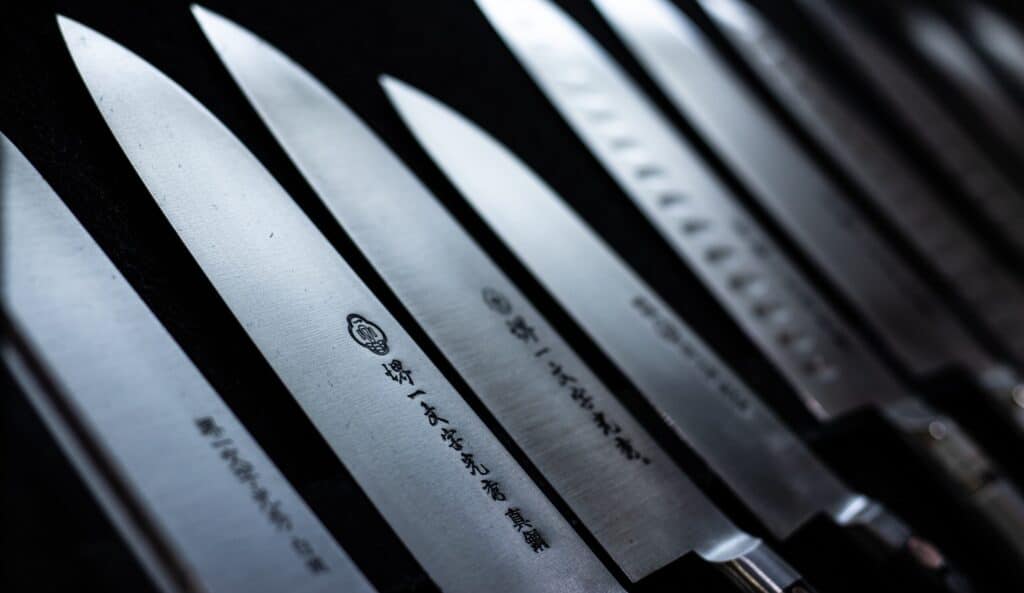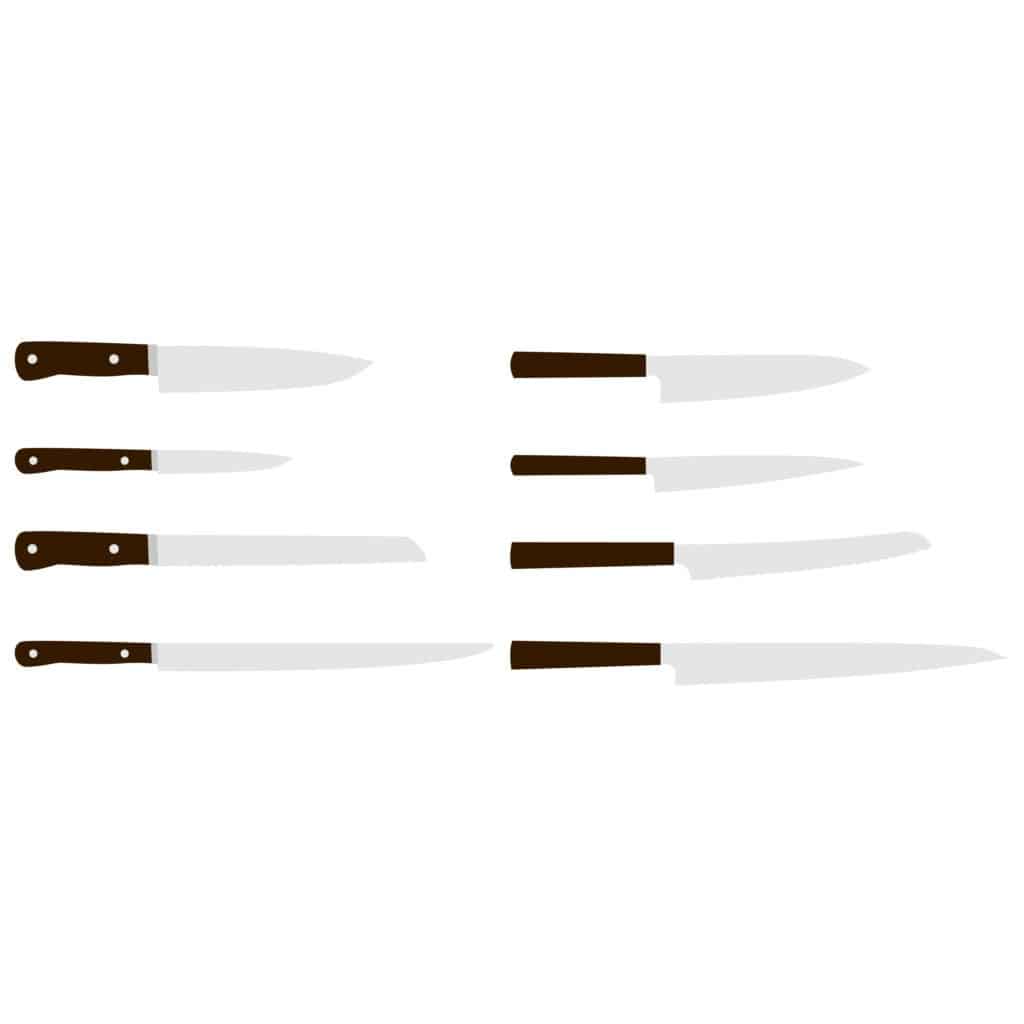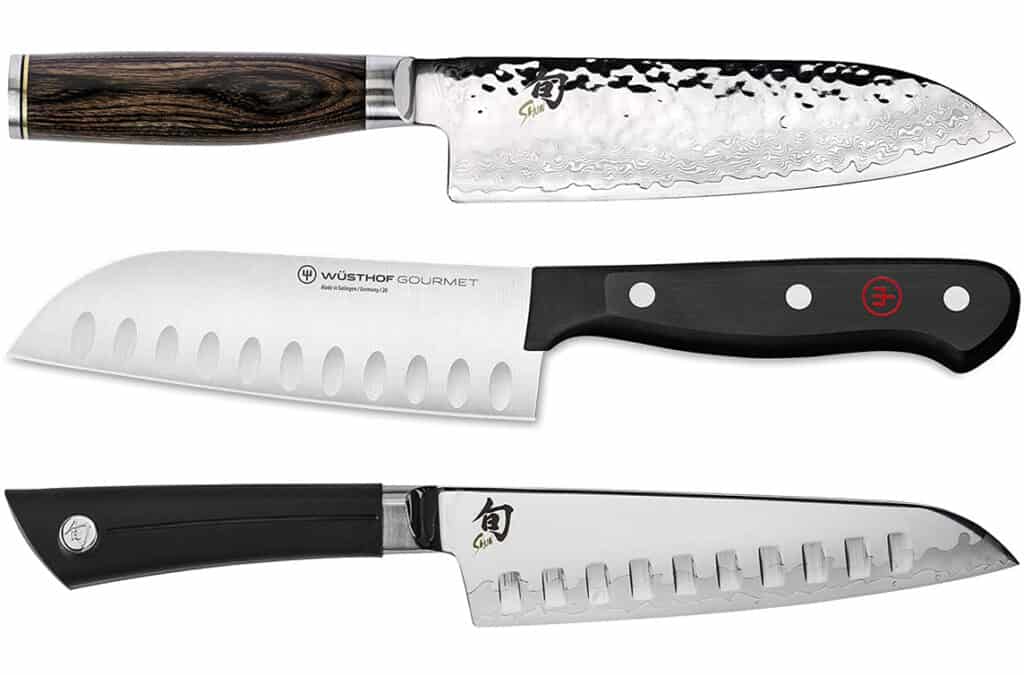
Santoku knives are the most popular kitchen knife in Japan, similar in many respects to the western chef’s knife. It is the ‘all-rounder’ of Japanese knife design, the knife which can be used for most cooking tasks.
The Santoku isn’t just confined to Japanese kitchens. It now has a strong presence in western knife ranges. If you buy a good quality kitchen knife set then there’s a high chance there will be a Santoku knife in there, even if every other knife is of a western style.
There’s good reason for the Santoku’s increasing popularity, it’s a very useful knife and offers an alternative to the chef’s knife which many people prefer. Users with smaller hands in particular often prefer the more petite Santoku.
In this article, I’m going to show you 9 different Santoku knives. They’re all brilliant knives and I’ve purposefully chosen a range of Santokus’ that differ widely in appearance and price, from a range of reputable knife manufacturers.
The Santoku I would recommend for home cooks is the Global 7 inch Santoku. It is extremely resistant to rust and made from flexible steel so it won’t chip easily. That’s extra useful for home kitchens where it might not always be easy to maintain a more brittle knife. I have a full review on the Global below. The price usually ranges from $120 – $140. It’s a worthy investment as this ultra-durable knife should last for decades.
View My Top Recommendation
You can view the Global 7 inch Santoku on Amazon here (opens new tab)
If the Global isn’t quite for you then check out the rest of my list, I’m sure you will be able to find the Santoku that suits your personal style and budget.
9 Best Santoku Knives
Here is my list of recommended Santoku knives, I’ve arranged them in price order.
All these knives use good quality materials and are made by great manufacturers. I’ve purposely chosen a range of knives with different prices and styles to give you a good choice of options.
All these knives are great, so your choice should depend on just how high quality a knife you want as well as the design you prefer. A knife such as the Shun Premier is for those who have a real interest in Japanese knife design and their high-quality steel. Whilst something like the Mac 6.5 inch Santoku is probably more appropriate for the general user.
I’ve also added a price range for each knife, as well as a link to check the current price on Amazon. These knives will frequently be offered at discounted rates, so I would recommend taking a look at the link for any knives you like just to see if you can grab a bargain.
| Name | Made in | Price | Check current price |
| Shun Premier 7 inch Santoku | Japan | $200 – $230 | View on Amazon |
| Yoshihiro 7 inch Santoku (best design) | Japan | $160 – $180 | View on Amazon |
| Global 7 inch Santoku (my top pick) | Japan | $120 – $140 | View on Amazon |
| Shun 7 inch hollow Santoku | Japan | $70 – $90 | View on Amazon |
| Mac 6.5 inch Santoku | Japan | $70 – $90 | View on Amazon |
| Zwilling J.A. Henckels 7 inch Santoku | Germany | $100 – $120 | View on Amazon |
| Wüsthof 7 inch Santoku | Germany | $80 – $100 | View on Amazon |
| Zelite 7 inch Santoku | China | $130 – $150 | View on Amazon |
| Dalstrong 7 inch Santoku | China | $70 – $90 | View on Amazon |
To learn more about any of these knives simply continue reading the article below.
Best Japanese Made Santoku Knives
Shun Premier 7 inch Santoku

View on Amazon (opens new tab)
Shun is a well-renowned manufacturer of Japanese knives. They use top quality materials and the premier version of their Santoku knife is certainly no exception. It’s the most expensive knife on this list, but it is absolutely stunning and incredibly well designed. I have also added another Shun model on this list which is a little less expensive.
The core steel for this blade is made from a top-quality steel exclusive to Shun knives, VG-MAX. It has a high carbon content making it extremely strong, holding a fantastic cutting edge for far longer than a standard Santoku. The cutting edge is sharpened to a 16-degree angle making for a very fine blade, many western chef’s knives only have an angle of around 20 degrees.
The core steel is clad with 68 layers of Damascus steel, which protects the core steel and looks outstandingly beautiful. The blade is also styled with a hammered Tsuchime finish, creating dimples on the blade which help food easily release from the knife when cutting, instead of getting stuck to the blade (a common issue with vegetables like potatoes).
The knife has a partial bolster and a full tang which stretches to the end cap. The handle is just as stunning as the blade and is made from a walnut finish, contoured pakkawood. Pakkawood is a wood composite that is often used for quality kitchen knife handles as it is strong and very resistant to water damage making it particularly durable. The handle has a slight curve to fit the shape of your handle for added comfort.
There is a well-sized heel to the knife and the balance between the blade and the handle is perfect. For anyone looking for an extra special Santoku knife to add to their kitchen collection then you can’t go wrong with this beauty.
Yoshihiro 7 inch Santoku
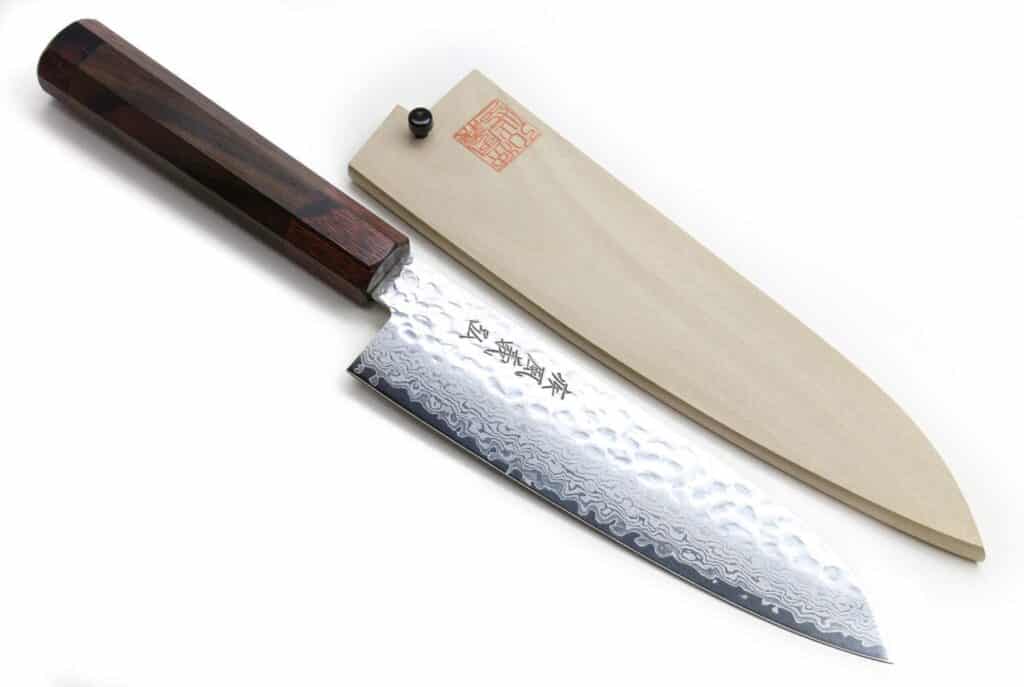
View on Amazon (opens new tab)
Yoshihiro is a Japanese knife manufacturer who has been one of Japan’s leading premium knife producers for over 100 years. This 7-inch Santoku is probably the most traditional looking knife on this list and it certainly is beautiful. Beauty isn’t its only asset though, this knife is made using the very best materials and this, combined with Yoshihiro rich knowledge of knife design leads to a truly fantastic Santoku.
The core of this knife uses VG-10 steel. This is high-quality Japanese steel with high carbon content. That makes the steel extremely hard meaning the blade can retain a particularly sharp cutting edge. The specific benefit of VG-10 though is that it has significantly better durability than some other Japanese steel due to its unique mix of Chromium, Molybdenum, Vanadium, Cobalt, and Manganese. In particular, the high Chromium content of 15% means the steel is resistant to rust and corrosion, whilst the other elements combine to give the steel added flexibility to reduce the naturally brittle nature of high carbon blades.
The blade is clad in a 46 layer Damascus steel exterior which gives a beautiful pattern on the blade surface as well as adding a dimpled surface to reduce the chance of food sticking to the blade when cutting.
There is no bolster on this blade and a partial tang. The lack of a bolster is quite common in traditional Japanese knife design. The handle is an octagonal shape tapered slightly towards the blade. It’s made from Shitan Rosewood with a redwood section where you would usually find the bolster. It’s a simple and beautifully designed handle and it’s angled shape helps you grip effectively.
This is a fantastically traditional Santoku with a simple, yet elegant design. For those of you looking for ‘the real deal’, you can’t do much better than this.
Global 7 inch Santoku

View on Amazon (opens new tab)
I’m a fan of Global knives because I think they are some of the most durable knives you can find. For the home cook who doesn’t want to have to worry about chipping the knife, or damaging the handle by leaving it soaked in water, Global knives can be a great choice with their combination of durability and high-quality materials.
Global knives are made from one piece of steel. That means the handle is made from the same piece of steel as the blade. The handle of a knife is often the first part to deteriorate and is the harder part to fix, a chipped blade can be sharpened and restored but a cracked handle usually requires a replacement.
The steel is highly durable too. Global use a steel called Cromova 18. The 18 stands for 18% chromium, the element which makes stainless steel resistant to rust and corrosion. A quality stainless steel knife often has around 15% chromium so this one is extremely resistant.
The blade has hollowed dimples that help prevent food from sticking to the side of the blade when slicing. As it’s one piece of steel there is no bolster, the handle is also hollowed out so the knife is very lightweight. The handle is also covered with non-slip dimples which provide a very good grip. The handle is a thin tapered cylinder and is especially useful for smaller hands.
The heel of the knife isn’t huge but Global has designed it so that the handle reverts inward towards the heel to enlarge it. What results is a reasonably sized heel which shouldn’t cause much of a problem, your knuckles should still have plenty of room unless you have particularly large hands.
As ever from Global, It’s a super-durable knife designed for practicality.
Shun 7 inch hollow Santoku

View on Amazon (opens new tab)
I’ve already listed a Shun knife in this article. It came first on the list as it’s the most expensive. Shun is a fantastic producer of Japanese knives so I wanted to offer another alternative of theirs for a lower price.
The steel for the blade is VG-10, a very high-quality Japanese steel that has high carbon content making the blade extremely strong, allowing for a sharper cutting edge and better edge retention. This Japanese steel is also combined with a number of other elements (chromium, molybdenum, vanadium and cobalt) which increase its durability compared with other Japanese steels. Its chromium content is 15%, that’s the element used to make stainless steel rust and corrosion-resistant. All of that combined makes for a fantastically sharp blade which is still durable.
The knife has a bolster attached to the handle. The handle is made from a thermoplastic polymer to make it both strong and resistant to water damage and temperature changes. It’s been styled in a traditional Japanese way, well rounded and tapering towards the blade. The blade has a hollowed dimple line near the cutting edge which helps prevent food from sticking to the knife when cutting.
The handle and blade are well balanced; however, the blade does not have a full tang going into the handle which can reduce the strength of the connection between the blade and handle.
There’s a well-sized heel to the knife leaving plenty of room for your knuckles as you slice.
Overall this is a great alternative to the premier Santoku Shun producer for a much lower price. The only real negative is the lack of a full tang but the remainder of the knife is made using very high-quality materials.
Mac 6.5 inch Santoku

View on Amazon (opens new tab)
Mac produces a range of high-quality knives in a Japanese style using high-quality materials.
The Mac Santoku is the only knife on this list to use the steel AUS-8 for the blade. AUS-8 has a great reputation for being both strong and durable. It’s Japanese steel with very high carbon content, making it extremely strong. It also has a mixture of other elements (nickel, manganese, silicon, vanadium, chromium and molybdenum) which increase its flexibility and improve its resistance to rust and corrosion. It’ll need a bit more looking after than, say, the ultra-durable steel of the Global knife, but it’s fantastic steel for getting a super-sharp cutting edge which has great edge retention whilst still maintaining a level of flexibility.
The knife has no bolster and a full tang going into the handle. The handle is triple-riveted and made from Pakkawood. Pakkawood is a wood composite often used for the handles of quality knives, especially Japanese knives. It’s both strong and very durable, resistant to corrosion and water damage.
The handle shape is quite Japanese, well-rounded and tapered towards the blade. It is comfortable to hold and feels sturdy. There is also a good heel on the knife leaving plenty of room for your knuckles when slicing.
This is a simple Santoku but it uses very high-quality steel for the blade itself, meaning that you can get that ultra-sharp edge which is always a highlight of Japanese knife styles. It’s lightweight and comfortable to use, a really good all-rounder in the kitchen.
Best German Made Santoku Knives
Zwilling J.A. Henckels 7 inch Santoku

View on Amazon (opens new tab)
Zwilling is one of the largest producers of western-style kitchen knives in the world. It’s a sign that Santoku knives have become so popular in western kitchens that they now also produce a top-quality Santoku knife.
This knife is produced in Germany using German steel. The steel used goes through a Friodur process in which the steel is ice-hardened by putting it through a four-stage process where it is frozen to -94°F. This process makes this steel exceptionally hard and corrosion-resistant. The steel also has a very high carbon content so it can have a sharp edge with great edge retention. The mix of hardness and durability is typical in quality german steels and it makes for a fantastic and long-lasting knife blade.
As is common with Santoku knives the blade has a line of hollowed dimples which reduce the chance of food sticking to the knife when slicing. There is no bolster on the knife and it has a full tang going into the handle. The handle is more western in its design, triple-riveted with rounded edges. It has been shaped into an ergonomic design and is black in color. The handle is made using a thermoplastic called Polyoxymethylene, this makes it very resistant to any water damage or temperature changes.
The handle is comfortable and the knife is very lightweight overall. There is a well-sized heel on the knife leaving plenty of room for your knuckles.
It’s a high quality and durable knife from one of the leading knife manufacturers in the world.
Wüsthof 7 inch Santoku

View on Amazon (opens new tab)
Wüsthof is another giant in the western knife manufacturing world but they do also make fantastic Santoku knives. As ever with Wüsthof, this knife is made using simple design principles using high-quality materials.
The steel used for the blade is a high carbon German stainless steel. It’s hard enough to have a razor-sharp cutting edge which retains its sharpness very well but also flexible enough to stand the wear and tear of a home kitchen. It also has a good amount of chromium in the blade making it resistant to rust and corrosion. It’s typically of quality german steel with a great balance between hardness and durability that’s especially useful for the home cook.
The blade of the knife has a line of hollowed oval dimples to help prevent food from sticking to the blade when slicing. There is no bolster on this knife and a full tang goes into a very classically western-styled handle. Triple-riveted with the subtle ergonomic design you will be used to on western kitchen knives, it’s classic, comfortable and typical of Wüsthof with its western influence on a Japanese style. The handle is made from a thermoplastic called polypropylene so it’s extremely durable and resistant to water and temperature changes.
The handle is slim so very suitable for smaller hands and there is a very generous heel to the knife, helping to keep your fingers from knocking against the cutting board whilst slicing.
You generally can’t go wrong with a Wüsthof knife, they stick to simple design principles to produce practical knives using quality materials and this Santoku is no different.
Best Chinese Made Santoku Knives
Zelite 7 inch Santoku
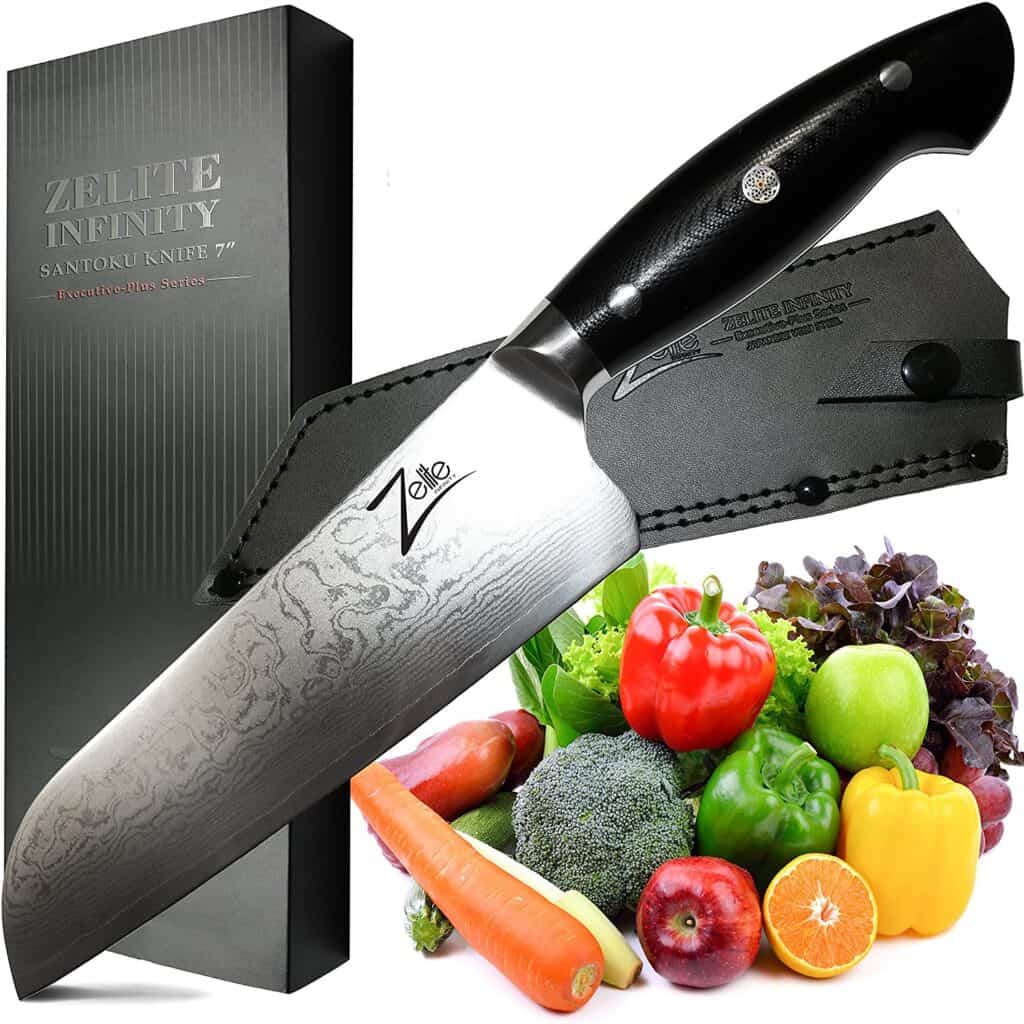
View on Amazon (opens new tab)
Zelite is a small family company. They have a great Japanese influenced range of knives using top quality materials. They also have their own distinct design and put particular focus on the ergonomics of the hand rather than sticking strictly to any classical handle designs.
This is another knife that uses a VG-10 steel core. It’s a fantastic Japanese steel that is high in carbon but also contains a mixture of chromium, molybdenum, vanadium and cobalt. This means that it’s very resistant to rust and corrosion (thanks to its 15% chromium content) as well as being more flexible than other high carbon knives, increasing its durability.
The core steel is clad in 67 layer Damascus with a beautiful Tsunami Rose Damascus Pattern finish which is unique to Zelite. The blade has a partial bolster and full tang going into the riveted handle.
Like all Zelite knives, the handle has been specifically designed for high ergonomics rather than sticking to conventional Japanese designs. It has a humpback and underside with a ridge at the rear. It is very comfortable to hold and the shaping makes it easy to control the knife as it doesn’t tend to slip very easily.
There is a generous heel on the knife allowing for plenty of room for your knuckles and the edges of the blades are quite rounded to provide extra safety.
This is a very practical knife using top quality materials. It’s significantly less than the two I’ve already mentioned but you still get a VG-10 steel core in a very well designed knife so it’s quite a good deal if you’re looking for a high-performance Santoku.
Dalstrong 7 inch Santoku
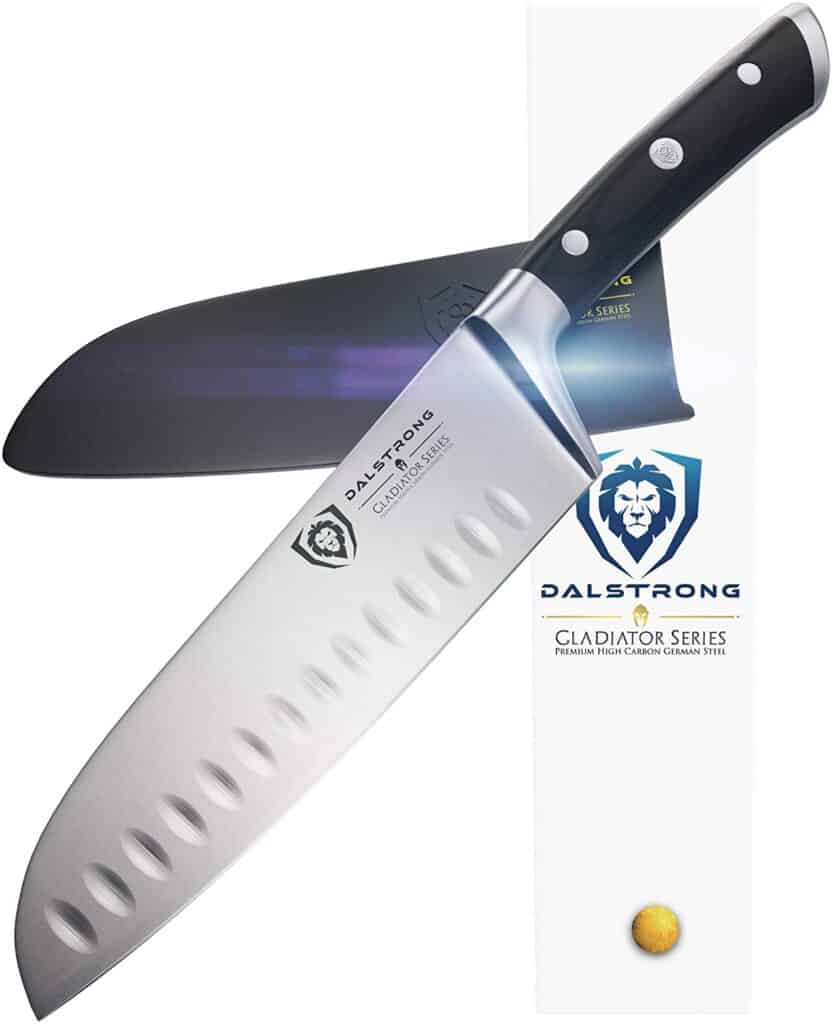
View on Amazon (opens new tab)
Last, but certainly not least on my list is this Dalstrong knife. Dalstrong has a range of great knives and they are often distinguishable by their bulky, reliable looking appearance. This Dalstrong Santoku is no different and it is the only knife on this list to feature a full bolster.
The blade is made from a high carbon German stainless steel. It’s extremely strong and resistant to rust and corrosion with added flexibility meaning it is more durable than other high carbon knives. That increased amount of carbon means that the edge can be sharpened to a particularly low angle and this knife has a 16-degree edge. The side of the blade has a line of hollowed dimples that stops food from sticking to the blade when slicing.
The blade has a full bolster, unusual for Santoku knives, it certainly adds an extra amount of stability and robustness to the knife. There is a full tang going into the handle and the handle is riveted. The handle is designed in a Japanese style, a curved cylinder in shape, tapering towards the knife blade. The handle is made from Pakkawood which is a great material producing durable knife handles, resistant to water and corrosion.
The full bolster runs down the heel, which is generous in its length giving you plenty of room for your knuckles. The bolster also adds an extra layer of protection between your fingers and the cutting edge.
This is a great knife, bulkier in style than many others on this list, it’s a great option for people who like to feel a bit more weight in their hand when using a knife.
